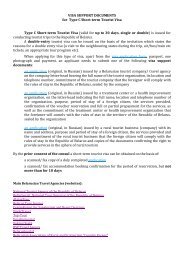BOX 1.7Social competencies: human development beyond the individualIndividuals cannot flourish alone; indeed, they cannot function alone. Thehuman development approach, however, has been essentially individualistic,assuming that development is the expansion of individuals’ capabilitiesor freedoms. Yet there are aspects of societies that affect individuals butcannot be assessed at the individual level because they are based on relationships,such as how well families or communities function, summarizedfor society as a whole in the ideas of social cohesion and social inclusion.Individuals are bound up with others. Social institutions affect individuals’identities and choices. Being a member of a healthy society is an essentialpart of a thriving existence.So one task of the human development approach is to explore the natureof social institutions that are favourable for human flourishing. <strong>Development</strong>then has to be assessed not only for the short-run impact on individual capabilities,but also for whether society evolves in a way that supports humanflourishing. Social conditions affect not only the outcomes of individuals in aparticular society today, but also those of future generations.Social institutions are all institutions in which people act collectively(that is, they involve more than one person), other than profit-making marketinstitutions and the state. They include formal nongovernmental organizations,informal associations, cooperatives, producer associations,neighbourhood associations, sports clubs, savings associations and manymore. They also consist of norms and rules of behaviour affecting humandevelopment outcomes. For example, attitudes towards employment affectmaterial well-being, and norms of hierarchy and discrimination affectinequality, discrimination, empowerment, political freedom and so on. Todescribe what those institutions can be and do, and to understand how theyaffect individuals, we can use the term social competencies.Central to the human development perspective is that societal normsaffect people’s choices and behaviours towards others, thus influencingoutcomes in the whole community. Community norms and behaviourscan constrain choice in deleterious ways from a human developmentperspective—for example, ostracizing, or in extreme cases killing, thosewho make choices that contravene social rules. Families trapped in povertyby informal norms that support early marriage and dowry requirementsmight reject changes to such entrenched social norms. Social institutionschange over time, and those changes may be accompanied by social tensionif they hamper the interests of some groups while favouring others.Policy change is the outcome of a political struggle in which differentgroups (and individuals) support or oppose particular changes. In thisstruggle, unorganized individuals are generally powerless, but by joiningtogether they can acquire power collectively. Social action favouring humandevelopment (such as policies to extend education, progressive taxation andminimum wages) happens not spontaneously, but because of groups thatare effective in supporting change, such as producer groups, worker associations,social movements and political parties. These organizations are especiallycrucial for poorer people, as demonstrated by a group of sex workersin Kolkata, India, and women in a squatter community in Cape Town, SouthAfrica, who improved their conditions and self-respect by joining togetherand exerting collective pressure.Societies vary widely in the number, functions, effectiveness and consequencesof their social competencies. Institutions and norms can be classifiedas human development–promoting, human development–neutral andhuman development–undermining. It is fundamental to identify and encouragethose that promote valuable capabilities and relationships among andbetween individuals and institutions. Some social institutions (includingnorms) can support human development in some respects but not in others:for example, strong family bonds can provide individuals with support duringupheavals, but may constrain individual choices and opportunities.Broadly speaking, institutions that promote social cohesion and humandevelopment show low levels of disparity across groups (for example,ethnic, religious or gender groups) and high levels of interaction and trustamong people and across groups, which results in solidarity and the absenceof violent conflict. It is not a coincidence that 5 of the 10 most peacefulcountries in the world in 2012, according to the Global Peace Index, are alsoamong the most equal societies as measured by loss in <strong>Human</strong> <strong>Development</strong>Index value due to inequality. They are also characterized by the absence ofdiscrimination and low levels of marginalization. In some instances antidiscriminatorymeasures can ease the burden of marginalization and partiallymitigate the worst effects of exclusion. For instance, US law mandating thathospital emergency rooms offer treatment to all patients regardless of theirability to pay partly mitigates the impact of an expensive health care systemwith limited coverage, while affirmative action in a range of countries (includingBrazil, Malaysia, South Africa and the United States) has improvedthe situation of deprived groups and contributed to social stability.The study of social institutions and social competencies must form anessential part of the human development approach—including the formationof groups; interactions between groups and individuals; incentives andconstraints to collective action; the relationship among groups, politics andpolicy outcomes; the role of norms in influencing behaviours; and how normsare formed and changed.Source: Stewart <strong>2013</strong>; Institute for Economics and Peace 2012.the United Kingdom in particular, as inequalityrose, intergenerational mobility declined.The 2010 Latin America and the Caribbean<strong>Human</strong> <strong>Development</strong> <strong>Report</strong> highlighted thelink between the lack of social mobility andpersistent inequality. 50 In Brazil, at least aquarter of inequality in earnings is associatedwith household circumstances, such asparents’ educational attainment, race or ethnicity,or place of birth. 51 Such persistence of incomedistribution patterns across generationsis also evident in Chile and Mexico, althoughMexico has seen increased intergenerationalmobility in recent years. 52 Generally, LatinAmerica suffers from low social mobility,stifling opportunities for individuals at the36 | HUMAN DEVELOPMENT REPORT <strong>2013</strong>
ottom of the income distribution for whomperformance in society is determined largelyby background characteristics beyond theircontrol. The problem is particularly intractablein heterogeneous societies, as members ofdeprived groups find it particularly difficult toprogress.Inequity and exclusion endure when theexcluded and those at the lower ends of thedistribution lack the political voice to seekredress. More-equal and more-just societies,essential for satisfactory and sustainable humanprogress, thus require greater voice andpolitical participation and more-accountablegovernments (box 1.8).Even in the European Union, where a largepart of the population has seen rising prosperity,some groups have been left behind. TheRoma, for example, have been part of Europeancivilization for more than a thousand years.With an estimated 7–9 million people, they areEurope’s biggest ethnic minority, present in all27 EU member states. Most are EU citizens butcontinue to suffer discrimination and social exclusion.As two regional <strong>Human</strong> <strong>Development</strong><strong>Report</strong>s have revealed, the Roma are oftentrapped in a vicious cycle of social exclusionthat has persisted generation after generation. 53The presence of inequalities can adverselyaffect social interactions and restrict freedomThe presence ofinequalities canadversely affect socialinteractions and restrictfreedom of choiceBOX 1.8Poverty’s structural dimensionsThe traditional agendas for reducing poverty recognize but inadequately addressits structural sources. Contemporary interventions to promote inclusivegrowth have tended to focus on the outcomes of development throughexpanding and strengthening social safety nets. While such public initiativesare to be encouraged, they address the symptoms of poverty, not its sources.The results of such restrictive interventions are reduction of income povertyto varying degrees and some improvement in human development. Butacross much of the South, income inequalities have increased, social disparitieshave widened and injustice remains pervasive, while the structuralsources of poverty remain intact. Any credible agenda to end poverty mustcorrect the structural injustices that perpetuate it.Unequal access to assetsInequitable access to wealth and knowledge disempowers the excludedfrom competing in the marketplace. Rural poverty, for example, originatesin insufficient access to land and water for less privileged segments of ruralsociety. Land ownership has been not only a source of economic privilege,but also a source of social and political authority. The prevailing structures ofland ownership remain inimical to a functioning democratic order. Similarly,lack of access to capital and property perpetuates urban poverty.Unequal participation in the marketWith the prevailing property structures of society, the resource-poor remainexcluded from more-dynamic market sectors. The main agents of productiontend to be the urban elite, who own the corporate assets that powerfaster growing economic sectors. By contrast, the excluded partake only asprimary producers and wage earners, at the lowest end of the productionand marketing chains, leaving them with little opportunity to share in marketeconomy opportunities for adding value to their labour.Capital markets have failed to provide sufficient credit to the excluded,even though they have demonstrated their creditworthiness through lowdefault rates in the microcredit market. And formal capital markets havenot provided financial instruments to attract the savings of the excludedand transform them into investment assets in the faster growing corporatesector.Unjust governanceThis inequitable and unjust social and economic universe can be compoundedby unjust governance. Often the excluded remain voiceless in theinstitutions of governance and thus underserved by public institutions. Theinstitutions of democracy remain unresponsive to the needs of the excluded,both in the design of policy agendas and in the selection of electoral candidates.Representative institutions thus tend to be monopolized by the affluentand socially powerful, who then use office to enhance their wealth andperpetuate their hold over power.Promoting structural changeTo correct these structural injustices, policy agendas need to be mademore inclusive by strengthening the capacity of the excluded to participateon more equitable terms in the market economy and the democraticpolity. Such agendas should reposition the excluded within the processesof production, distribution and governance. The production process needsto graduate the excluded from living out their lives exclusively as wageearners and tenant farmers by investing them with the capacity to becomeowners of productive assets. The distribution process must elevate the excludedbeyond their inherited role as primary producers by enabling themto move upmarket through greater opportunities to share in adding valuethrough collective action. Access to assets and markets must be backed byequitable access to quality health care and education, integral to empoweringthe excluded.The governance process must increase the active participation ofthe excluded in representative institutions, which is crucial to enhancingtheir voice in decisionmaking and providing access to the institutions ofgovernance.Source: Sobhan, R. 2010. Challenging the Injustice of Poverty.Chapter 1 The state of human development | 37
- Page 1 and 2: WNSEHuman DevelopmentReport 2013The
- Page 3 and 4: Human Development Report 2013The Ri
- Page 5 and 6: Human Development Report 2013 TeamD
- Page 7 and 8: Finally, the Report also calls for
- Page 9 and 10: Heather Simpson, Ben Slay, Mounir T
- Page 11 and 12: 3.6 India’s Supreme Court issues
- Page 13 and 14: OverviewOne of the most heartening
- Page 15 and 16: and sustainability are fully incorp
- Page 17 and 18: Without investment in people, retur
- Page 19 and 20: opportunity to reap the full benefi
- Page 21 and 22: Woods institutions, the United Nati
- Page 23 and 24: IntroductionWhen developed economie
- Page 25 and 26: leading economies—Brazil, China a
- Page 27 and 28: comparable access to information, e
- Page 29 and 30: mobile phones: cellular banking is
- Page 32 and 33: “The political problem ofmankind
- Page 34 and 35: BOX 1.1Fairness, macroeconomics and
- Page 36 and 37: BOX 1.3Amartya Sen, Nobel Laureate
- Page 38 and 39: FIGURE 1.1Income per capita is risi
- Page 40 and 41: BOX 1.4Subjective indicators of wel
- Page 42 and 43: FIGURE 1.4There is notable variatio
- Page 44 and 45: FIGURE 1.6Most regions show declini
- Page 46 and 47: Progress in humandevelopment achiev
- Page 50 and 51: TABLE 1.3Inequality and satisfactio
- Page 52 and 53: Not all countries havethe precondit
- Page 54 and 55: “When the music changes,so does t
- Page 56 and 57: BOX 2.1The South’s integration wi
- Page 58 and 59: FIGURE 2.1As a share of world merch
- Page 60 and 61: BOX 2.2Acquisitions by the South of
- Page 62 and 63: FIGURE 2.3Between 2000 and 2010, In
- Page 64 and 65: FIGURE 2.4Export earnings per capit
- Page 66 and 67: BOX 2.6Final assembly is about more
- Page 68 and 69: Instead of having a centreof indust
- Page 70 and 71: FIGURE 2.6Emerging market economies
- Page 72 and 73: Developing countriestrade more amon
- Page 74 and 75: “We cannot expect thatall nations
- Page 76 and 77: TABLE 3.1Selected developing countr
- Page 78 and 79: A common featureof countries thatha
- Page 80 and 81: More important thangetting prices r
- Page 82 and 83: BOX 3.5Eastern Europe and Central A
- Page 84 and 85: States have to beconscious that the
- Page 86 and 87: As countries develop,they tend to d
- Page 88 and 89: Having weathered theAsian financial
- Page 90 and 91: Providing publicservices that contr
- Page 92 and 93: Advancing health requiresmore than
- Page 94 and 95: Universal public healthand educatio
- Page 96 and 97: • China. The Minimum Livelihood G
- Page 98 and 99:
“Each generation will reap whatth
- Page 100 and 101:
concerns will make for a complex en
- Page 102 and 103:
A greater emphasison education cans
- Page 104 and 105:
FIGURE 4.1Under the fast track scen
- Page 106 and 107:
Around the worldpeople are calling
- Page 108 and 109:
FIGURE 4.4Different environmental s
- Page 110 and 111:
FIGURE 4.5Education policies can al
- Page 112 and 113:
BOX 4.2China and Ghana: who benefit
- Page 114 and 115:
FIGURE 4.8countries thus converge t
- Page 116 and 117:
“Let us join hands to try tocreat
- Page 118 and 119:
Areas of globalinternational concer
- Page 120 and 121:
Addressing climatechange requires t
- Page 122 and 123:
International governanceis increasi
- Page 124 and 125:
BOX 5.2Jo Leinen, Member of the Eur
- Page 126 and 127:
facilitates reserve investments and
- Page 128 and 129:
Responsible sovereigntytakes the lo
- Page 130 and 131:
FIGURE 5.1Under the accelerated pro
- Page 132 and 133:
Good policymakingrequires greater f
- Page 134 and 135:
A fair and less unequalworld requir
- Page 137 and 138:
NotesOverview1 Atsmon and others 20
- Page 139 and 140:
25 Blinder 2006.26 UNIDO 2009.27 UN
- Page 141 and 142:
which is 61.7 deaths per 1,000 live
- Page 143 and 144:
ReferencesAbdurazakov, A., A. Minsa
- Page 145 and 146:
urban_world_cities_and_the_rise_of_
- Page 147 and 148:
Kamau, P., D. McCormick, and N. Pin
- Page 149 and 150:
Labor Administration. Geneva: Inter
- Page 151 and 152:
Human Development Report 2013The Ri
- Page 153 and 154:
Statistical acknowledgementsThe Rep
- Page 155 and 156:
Key to HDI countries and ranks, 201
- Page 157 and 158:
Human Development Report 2013The Ri
- Page 159 and 160:
Human Development Report 2013The Ri
- Page 161 and 162:
Human Development Report 2013The Ri
- Page 163 and 164:
Human Development Report 2013The Ri
- Page 165 and 166:
Human Development Report 2013The Ri
- Page 167 and 168:
Human Development Report 2013The Ri
- Page 169 and 170:
Human Development Report 2013The Ri
- Page 171 and 172:
Human Development Report 2013The Ri
- Page 173 and 174:
Human Development Report 2013The Ri
- Page 175 and 176:
Human Development Report 2013The Ri
- Page 177 and 178:
Human Development Report 2013The Ri
- Page 179 and 180:
Human Development Report 2013The Ri
- Page 181 and 182:
Human Development Report 2013The Ri
- Page 183 and 184:
Human Development Report 2013The Ri
- Page 185 and 186:
Human Development Report 2013The Ri
- Page 187 and 188:
Human Development Report 2013The Ri
- Page 189 and 190:
Human Development Report 2013The Ri
- Page 191 and 192:
Human Development Report 2013The Ri
- Page 193 and 194:
Human Development Report 2013The Ri
- Page 195 and 196:
Human Development Report 2013The Ri
- Page 197 and 198:
Human Development Report 2013The Ri
- Page 199 and 200:
Human Development Report 2013The Ri
- Page 201 and 202:
Human Development Report 2013The Ri
- Page 203 and 204:
Human Development Report 2013The Ri
- Page 205 and 206:
Human Development Report 2013The Ri
- Page 207 and 208:
Human Development Report 2013The Ri
- Page 209 and 210:
Human Development Report 2013The Ri
- Page 211 and 212:
Statistical referencesADB (Asian De
- Page 213 and 214:
Core features of the model pertinen
- Page 215 and 216:
Countries and HDI ranks in 2012 and
















